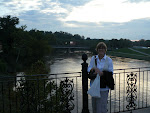 world of Twitter. Boy was I wrong. Last night I started reading the July/August issue of Poets & Writers Magazine and there it was, on page 18—a new multi-speech-part word: “flarf.” Sounds like preadolescent male bathroom humor, but it’s really a new literary term, created about ten years ago by a group of people who knew how to write poetry but were searching for a new, entertaining art form. According to the story, "Can Flarf Ever Be Taken Seriously?" by Shell Fischer, flarfers do random word-searches on the net, email the results to each other, and use the phrases to create poems called “flarfs.” Since their inception, “flarfy” music, theater and film have been born, and in November, Edge Books will publish Flarf: An Anthology of Flarf, which will feature the work of 25-30 poets.
world of Twitter. Boy was I wrong. Last night I started reading the July/August issue of Poets & Writers Magazine and there it was, on page 18—a new multi-speech-part word: “flarf.” Sounds like preadolescent male bathroom humor, but it’s really a new literary term, created about ten years ago by a group of people who knew how to write poetry but were searching for a new, entertaining art form. According to the story, "Can Flarf Ever Be Taken Seriously?" by Shell Fischer, flarfers do random word-searches on the net, email the results to each other, and use the phrases to create poems called “flarfs.” Since their inception, “flarfy” music, theater and film have been born, and in November, Edge Books will publish Flarf: An Anthology of Flarf, which will feature the work of 25-30 poets. What struck me about this new art form was the emphasis on the poets being “very well schooled in a variety of traditions of American poetry” before they attempted “flarf.” It reminds me of the importance of a visual artist learning the craft, as Picasso did, before attempting to abstract that craft. Why is that important? Because you have to know where true is. (And in case any of you are trembling at the thought that I’m going to attempt to write a flarf and share it on my blog, let not your heart be troubled—I would be breaking the tenet I am promoting, since I’m not a classically trained poet.)
I wish that phrase was original with me—“Once you know where true is….” but I got it from a book by Anne Lamott called Blue Shoe. The protagonist, Maggie, gets help from her friend Daniel, who is a construction worker, to build a new fence for her yard. He teaches her children, Harry and Ella, how to use a level to get the posts straight. He says, “Now that we know these posts are level and true, everything can be measured from them. Once you know where true is, it defines everything else that has to happen.”
 Flarf poets have to know where true is in order to flarf well. And ordinary people have to know where true is in order to do their Personal Best, which, according to New York Times film critic A. O. Scott, is to “be a hero.” Scott’s article, “10 Things Summer Blockbusters Teach Us About Life,” in the July issue of Real Simple Magazine, says that the “fundamentals of heroism are the same, whether you’re a film character or just an everyday good guy.”
Flarf poets have to know where true is in order to flarf well. And ordinary people have to know where true is in order to do their Personal Best, which, according to New York Times film critic A. O. Scott, is to “be a hero.” Scott’s article, “10 Things Summer Blockbusters Teach Us About Life,” in the July issue of Real Simple Magazine, says that the “fundamentals of heroism are the same, whether you’re a film character or just an everyday good guy.” When I read Scott’s article this morning, I was still thinking about the heroes who are fighting for truth and the Orthodox way in the Antiochian Archdiocese right now. And while their fight is much more serious (and real) than the wars waged by superheroes on the silver screen, the lessons Scott has gleaned from a decade of professional moviegoing are worth a look-see:
1. Heroes don’t always know that they’re heroes.

2. Herosim is a lonely, thankless vocation.
3. When the going gets tough, the usual rules don’t apply.
4. It’s always personal.
5. You can’t trust anyone.
6. There is always someone you can trust.
7. There is always enough time.
8. You should never get too comfortable.
9. Everything will be OK in the end.
10. There is always a sequel.
Read the (one-page) article to get Scott’s full wisdom on each of these tenets of heroism. My personal favorites are Number 4: It’s always personal and No. 10: There is always a sequel.
After you read them, please share your thoughts—leave me a comment, about heroes, flarfing, or whatever your take on doing your Personal Best.































































3 comments:
i think i'd have to read a flarf to know whether i liked it or not. if these people are trying to be serious, they should come up with a different "word."
i enjoyed Mr. Scott's article. his NYT reviews are always enjoyable, too. i wish i had his job!!!
--katie e.
I raise my glass of wine to you!! ..."Personal Best". rules to live by.
Here's an excellent update, from one of our "heroes": http://ocanews.org/news/MetShouldInvestigate6.26.09.html
Post a Comment